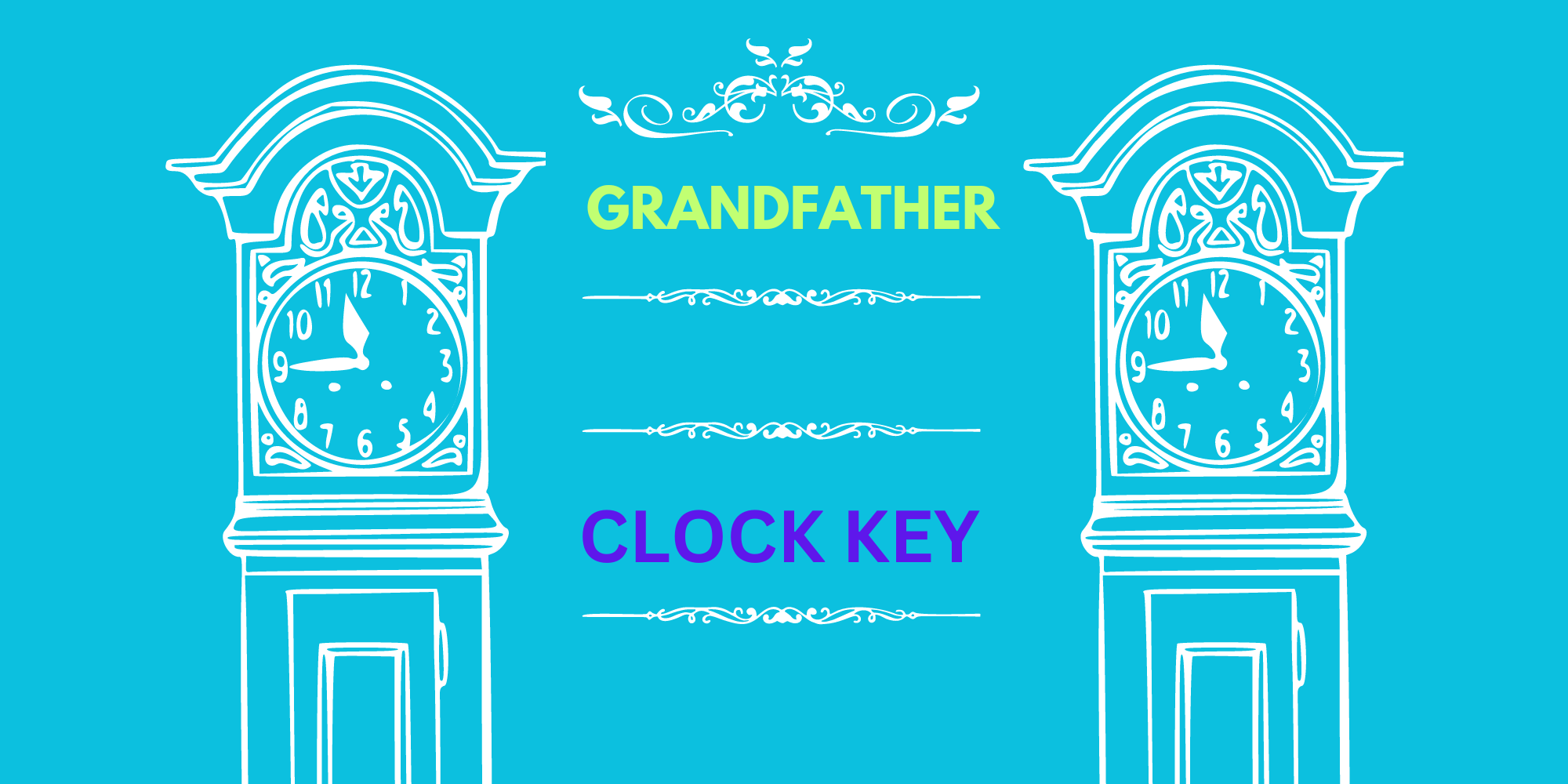Grandfather clocks are not just timepieces; they are treasured heirlooms that add charm and elegance to any space. These magnificent clocks require regular maintenance, and one essential component for their operation is the grandfather clock key. In this article, we will explore the significance of grandfather clock keys, and the different types of grandfather clocks, and provide useful information on choosing, using, and maintaining these keys.
What Are Grandfather Clock Keys?
Grandfather clock keys are specialized tools used to wind and regulate the timekeeping mechanisms of grandfather clocks. They are typically made of metal, featuring a long, slender handle with a winding square or hole at the end. The key’s design allows it to fit into specific parts of the clock, such as the winding arbor or the chime mechanism and enables the clock to be wound and set accurately.
Different Types of Grandfather Clocks
Grandfather clocks come in various designs, but they can be broadly categorized into two main types: weight-driven and spring-driven clocks.
Weight-Driven Grandfather Clocks
Weight-driven grandfather clocks rely on the force of gravity to power their timekeeping mechanism. These clocks feature weights that hang down from the clock’s movement and are responsible for driving the gears and maintaining the clock’s accuracy. To keep the clock running, the weights need to be raised periodically using a key.
Spring-Driven Grandfather Clocks
Spring-driven grandfather clocks, as the name suggests, utilize a coiled spring to power their mechanism. These clocks require regular winding to maintain their operation. The key is used to wind the spring, which stores potential energy and gradually releases it to drive the clock’s gears and pendulum.
The Importance of Grandfather Clock Keys
Grandfather clock keys play a vital role in keeping these timepieces running smoothly. Without the correct key, it would be impossible to wind the clock or adjust its various components accurately. Using the wrong key can damage delicate mechanisms or result in improper timekeeping. Therefore, having the right key is essential for the proper functioning and longevity of a grandfather clock.
Understanding Key Terminology
To choose the right key for your grandfather clock, it’s essential to understand key terminology, including key sizes and key types.
Key Sizes
Grandfather clock keys come in different sizes, denoted by a number or a measurement. The size is determined by the width of the square or the hole at the end of the key. It’s crucial to identify the correct key size for your clock to ensure a proper fit and prevent any potential damage.
Key Types
In addition to sizes, grandfather clock keys also come in various types, depending on their specific functions. Some common key types include the winding key, chime key, and door key. Each key serves a distinct purpose and is designed to fit a specific part of the clock.
How to Choose the Right Key
Choosing the right key for your grandfather clock is crucial to avoid any mishaps or damage. Here are a few steps to help you select the correct key:
- Determine the type of grandfather clock you have (weight-driven or spring-driven).
- Identify the keyholes or winding arbor where the key will be used.
- Measure the size of the square or hole where the key will fit.
- Consult a reputable clockmaker or specialist to assist you in selecting the appropriate key.
How to Wind a Grandfather Clock
Properly winding a grandfather clock is necessary for maintaining its accuracy and longevity. Here’s a step-by-step guide to winding a grandfather clock:
- Locate the keyholes or winding arbor for each function (time, chime, etc.).
- Insert the key into the appropriate keyhole or winding arbor.
- Turn the key gently and steadily clockwise until you meet resistance.
- Avoid overwinding the clock by paying attention to the tension and any audible clicking sounds.
- Once the clock is fully wound, remove the key and store it in a safe place.
Maintaining and Caring for Keys
To ensure your grandfather clock keys remain in good condition and function properly, follow these maintenance tips:
- Keep the keys in a dry and secure location, away from moisture or extreme temperatures.
- Clean the keys regularly with a soft, lint-free cloth to remove any dust or debris.
- Avoid applying excessive force or twisting motions when using the keys.
- Inspect the keys for any signs of wear or damage, and replace them if necessary.
Troubleshooting Common Key Issues
Despite proper care, key-related issues can occasionally occur with grandfather clocks. Here are a few common problems and their possible solutions:
Key Stuck in Lock
If your key becomes stuck in the lock, avoid using force to remove it. Instead, try gently wiggling the key or lubricating the lock with a small amount of graphite powder. If the issue persists, seek professional assistance.
Key Won’t Turn
If the key won’t turn when winding the clock, ensure it is the correct size and properly aligned with the keyhole or winding arbor. Lubricating the key or the mechanism with clock oil might also help. If the problem persists, consult a professional clock repairer.
Key Broken
In the unfortunate event of a broken key, it’s best to contact a clock specialist or a reputable clock parts supplier for a replacement. Attempting to repair the key yourself could lead to further damage.
Replacing Grandfather Clock Keys
If you need to replace a lost or damaged grandfather clock key, follow these steps:
- Determine the correct key size and type for your clock.
- Contact reputable clock parts suppliers or specialty stores.
- Provide the necessary information to ensure you receive the correct replacement key.
- Install the new key following the manufacturer’s instructions or seek professional assistance if needed.
Conclusion
Grandfather clock keys are vital components for the proper functioning and maintenance of these timeless treasures. By understanding key terminology, choosing the right key, and following proper winding and maintenance practices, you can ensure your grandfather clock remains accurate and continues to delight for generations to come.
FAQs
FAQ 1: Where can I find replacement keys for my grandfather clock? Replacement keys for grandfather clocks can be found at reputable clock parts suppliers, specialty stores, or by consulting professional clockmakers.
FAQ 2: Can I use any key to wind my grandfather clock? No, using the correct key size and type is essential to prevent damage and ensure proper operation. Using the wrong key can result in improper winding or potential harm to the clock mechanisms.
FAQ 3: How often should I wind my grandfather clock? The frequency of winding depends on the specific clock’s design. It is generally recommended to wind a grandfather clock once every seven to eight days. However, consult the clock’s manufacturer or a specialist for precise instructions.
FAQ 4: Can I fix a broken key myself? Repairing a broken key is best left to professionals. Attempting to fix it yourself may lead to further damage or compromise the key’s functionality.
FAQ 5: Are all grandfather clock keys the same size? No, grandfather clock keys come in various sizes to accommodate different clock models and mechanisms. It’s crucial to identify the correct key size for your specific clock to ensure a proper fit and avoid any potential issues.

Meet Aron Crock, a clock hardware expert with seven years of hands-on experience. Aron’s journey into the world of clocks began as a hobby, but his passion soon turned into a profession. He’s known for his deep understanding of clock mechanisms and is highly respected in the field. Aron’s dedication to making clocks tick with precision and his innovative ideas have made him a key player in the industry. He’s committed to pushing the boundaries of clock technology and leaving a lasting impact on the world of timekeeping. Aron Crock is a true clock enthusiast, and his expertise shines through in his work.

